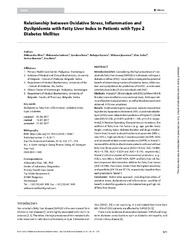Приказ основних података о документу
Relationship between Oxidative Stress, Inflammation and Dyslipidemia with Fatty Liver Index in Patients with Type 2 Diabetes Mellitus
| dc.creator | Klisić, Aleksandra | |
| dc.creator | Isaković, Aleksandra | |
| dc.creator | Kocić, Gordana | |
| dc.creator | Kavarić, Nebojša | |
| dc.creator | Jovanović, Milovan | |
| dc.creator | Zvrko, Elvir | |
| dc.creator | Skerović, Verica | |
| dc.creator | Ninić, Ana | |
| dc.date.accessioned | 2019-09-02T12:08:16Z | |
| dc.date.available | 2019-09-02T12:08:16Z | |
| dc.date.issued | 2018 | |
| dc.identifier.issn | 0947-7349 | |
| dc.identifier.uri | https://farfar.pharmacy.bg.ac.rs/handle/123456789/3233 | |
| dc.description.abstract | Introduction/Aim Considering the high prevalence of nonalcoholic fatty liver disease (NAFLD) in individuals with type 2 diabetes mellitus (DM2), we aimed to investigate the potential benefit of determining markers of oxidative stress, inflammation and dyslipidemia for prediction of NAFLD, as estimated with fatty liver index (FLI) in individuals with DM2. Methods A total of 139 individuals with DM2 (of them 49.9 % females) were enrolled in cross-sectional study. Anthropometric and biochemical parameters, as well as blood pressure were obtained. A FLI was calculated. Results Multivariate logistic regression analysis showed that high density lipoprotein cholesterol (HDL-c) and malondialdehyde (MDA) were independent predictors of higher FLI [Odds ratio (OR) = 0.056, p = 0.029; and OR = 1.105, p = 0.016, respectively]. In Receiver Operating Characteristic curve analysis, the addition of fatty liver risk factors (e.g., age, gender, body height, smoking status, diabetes duration and drugs metabolized in liver) to each analysed biochemical parameter [HDL-c, non-HDL-c, high sensitivity C-reactive protein (hsCRP), MDA and advanced oxidant protein products (AOPP)] in Model 1, increased the ability to discriminate patients with and without fatty liver [Area under the curve (AUC) = 0.832, AUC = 0.808, AUC = 0.798, AUC = 0.824 and AUC = 0.743, respectively]. Model 2 (which included all five examined predictors, e.g., HDL-c, non-HDL-c, hsCRP, MDA, AOPP, and fatty liver risk factors) improved discriminative abilities for fatty liver status (AUC = 0.909). Even more, Model 2 had the highest sensitivity and specificity (89.3 % and 87.5 %, respectively) together than each predictor in Model 1. Conclusion Multimarker approach, including biomarkers of oxidative stress, dyslipidemia and inflammation, could be of benefit in identifying patients with diabetes being at high risk of fatty liver disease. | en |
| dc.publisher | Johann Ambrosius Barth Verlag Medizinverlage Heidelberg Gmbh, Stuttgart | |
| dc.relation | info:eu-repo/grantAgreement/MESTD/Basic Research (BR or ON)/175035/RS// | |
| dc.rights | openAccess | |
| dc.source | Experimental and Clinical Endocrinology & Diabetes | |
| dc.subject | dyslipidemia | en |
| dc.subject | fatty liver | en |
| dc.subject | inflammation | en |
| dc.subject | oxidative stress | en |
| dc.subject | type 2 diabetes | en |
| dc.title | Relationship between Oxidative Stress, Inflammation and Dyslipidemia with Fatty Liver Index in Patients with Type 2 Diabetes Mellitus | en |
| dc.type | article | |
| dc.rights.license | ARR | |
| dcterms.abstract | Клисић, Aлександра; Исаковић, Aлександра; Нинић, Aна; Скеровић, Верица; Зврко, Елвир; Јовановић, Милован; Каварић, Небојша; Коцић, Гордана; | |
| dc.citation.volume | 126 | |
| dc.citation.issue | 6 | |
| dc.citation.spage | 371 | |
| dc.citation.epage | 378 | |
| dc.citation.other | 126(6): 371-378 | |
| dc.citation.rank | M23 | |
| dc.identifier.wos | 000435299900007 | |
| dc.identifier.doi | 10.1055/s-0043-118667 | |
| dc.identifier.pmid | 28895641 | |
| dc.identifier.scopus | 2-s2.0-85048711816 | |
| dc.identifier.fulltext | https://farfar.pharmacy.bg.ac.rs//bitstream/id/1811/3231.pdf | |
| dc.type.version | publishedVersion |

